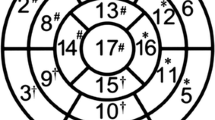Abstract
Purpose
The aim of this study was to investigate the influence of a computer-based decision support system (DSS) on performance and inter-observer variability of interpretations regarding ischaemia and infarction in myocardial perfusion scintigraphy (MPS).
Methods
Seven physicians independently interpreted 97 MPS studies, first without and then with the advice of a DSS. Four physicians had long experience and three had limited experience in the interpretation of MPS. Each study was interpreted regarding myocardial ischaemia and infarction in five myocardial regions. The patients had undergone a gated MPS using a 2-day stress/gated rest 99mTc sestamibi protocol. The gold standard used was the interpretations made by one experienced nuclear medicine specialist on the basis of all available clinical and image information.
Results
The sensitivity for ischaemia of the seven readers increased from 81% without the DSS to 86% with the DSS (p = 0.01). The increase in sensitivity was higher for the three inexperienced physicians (9%) than for the four experienced physicians (2%). There was no significant change in specificity between the interpretations. The interpretations of ischaemia made with the advice of the DSS showed less inter-observer variability than those made without advice.
Conclusion
This study shows that a DSS can improve performance and reduces the inter-observer variability of interpretations in myocardial perfusion imaging. Both experienced and, especially, inexperienced physicians can improve their interpretation with the advice from such a system.
Similar content being viewed by others
References
Kawamoto K, Houlihan CA, Balas EA, Lobach DF. Improving clinical practice using clinical decision support systems: a systematic review of trials to identify features critical to success. BMJ 2005;330:765.
Garcia EV, Cooke CD, Folks RD, Santana CA, Krawczynska EG, Braal LD, Ezquerra NF. Diagnostic performance of an expert system for the interpretation of myocardial perfusion SPECT studies. J Nucl Med 2001;42:1185–91.
Haddad M, Adlassnig KP, Porenta G. Feasibility analysis of a case-based reasoning system for automated detection of coronary heart disease from myocardial scintigrams. Artif Intell Med 1997;9:61–78.
Khorsand A, Graf S, Sochor H, Schuster E, Porenta G. Automated assessment of myocardial SPECT perfusion scintigraphy: a comparison of different approaches of case-based reasoning. Artif Intell Med 2007;40:103–13.
Fujita H, Katafuchi T, Uehara T, Nishimura T. Application of artificial neural network to computer-aided diagnosis of coronary artery disease in myocardial SPECT bull’s-eye images. J Nucl Med 1992;33:272–6.
Porenta G, Dorffner G, Kundrat S, Petta P, Duit-Schedlmayer J, Sochor H. Automated interpretation of planar thallium-201-dipyridamole stress-redistribution scintigrams using artificial neural networks. J Nucl Med 1994;35:2041–7.
Hamilton D, Riley PJ, Mioloa UJ, Amro AA. A feed forward neural network for classification of bull’s-eye myocardial perfusion images. Eur J Nucl Med 1995;22:108–15.
Lindahl D, Palmer J, Ohlsson M, Peterson C, Lundin A, Edenbrandt L. Automated interpretation of myocardial SPECT perfusion images using artificial neural networks. J Nucl Med. 1997;38:1870–5.
Gjertsson P, Lomsky M, Richter J, Ohlsson M, Tout D, van Aswegen A, et al. The added value of ECG-gating for the diagnosis of myocardial infarction using myocardial perfusion scintigraphy and artificial neural networks. Clin Physiol Funct Imaging 2006;26:301.
Lomsky M, Richter J, Johansson L, Hoilund-Carlsen PF, Edenbrandt L. Validation of a new automated method for analysis of gated-SPECT images. Clin Physiol Funct Imaging 2006;26:139.
Van Train KF, Areeda J, Garcia EV, Cooke CD, Maddahi J, Kiat H, et al. Quantitative same-day rest-stress technetium-99m-sestamibi SPECT: definition and validation of stress normal limits and criteria for abnormality. J Nucl Med 1993;34:1494.
Van Train KF, Garcia EV, Maddahi J, Areeda J, Cooke CD, Kiat H, et al. Multicenter trial validation for quantitative analysis of same-day rest-stress technetium-99m-sestamibi myocardial tomograms. J Nucl Med 1994;35:609.
Lindahl D, Lanke J, Lundin A, Palmer J, Edenbrandt L. Improved classifications of myocardial bull’s-eye scintigrams with computer-based decision support system. J Nucl Med 1999;40(1):96–101.
Acknowledgements
This study was supported by a scholarship from Medicon Valley Association.
Conflicts of interests statement
Kristina Tägil and Lars Edenbrandt are shareholders in Exini Diagnostics AB, which owns the EXINI heart software used in the study.
Author information
Authors and Affiliations
Corresponding author
Rights and permissions
About this article
Cite this article
Tägil, K., Bondouy, M., Chaborel, J.P. et al. A decision support system improves the interpretation of myocardial perfusion imaging. Eur J Nucl Med Mol Imaging 35, 1602–1607 (2008). https://doi.org/10.1007/s00259-008-0807-0
Received:
Accepted:
Published:
Issue Date:
DOI: https://doi.org/10.1007/s00259-008-0807-0




